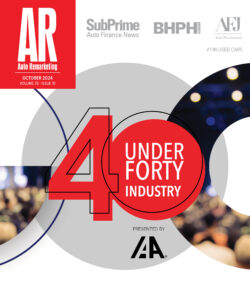How to Find Scarce Luxury Models for Your CPO Lot

Based on recent AutoTrader.com vehicle scarcity data sent to Auto Remarketing, luxury models might be the most difficult crop of certified pre-owned-worthy units to find for your lot.
In fact, seven of the top 10 spots on AutoTrader’s national CPO scarcity list from February were luxury models. In March, eight of the top 10 were luxury models.
During both months, luxury models also topped all of the site’s CPO scarcity lists for individual markets, as well.
So, if you are a luxury franchise dealer, how can you combat this scarcity in order to fulfill the inventory needs for your certified pre-owned operation?
We turned to the inventory experts to find out.
Summers: 3 Key Strategies
Jeff Summers, the chief executive officer of FirstLook Systems, boiled his advice down to three key areas.
The first, he said, is to increase the close rates during the appraisal process.
“And the No. 1 strategy we’re seeing for that, particularly in the luxury market, is what we call ‘value-based pricing,’” Summers said, “which is essentially recognizing that this is a high-margin potential car, and not only pricing it that way when they put it on the lot, but also using that same value-based approach when they appraise the car, as well.”
In essence, Summers said, a dealer should realize he or she is going to pay a bit more for the trade, “based on the fact that I know that this is a bigger-margin car.”
He added: “The person who ultimately buys this car is going to be driven more by the quality they see here than price; not that they will be completely price-insensitive, but given the fact that the primary driver here is going to be quality, we ought to recognize that and build that into the appraisal.”
Second, Summers touched on a teamwork approach to inventory management utilized by medium- to large-sized dealership groups.
“Specifically, they’re looking at in-group redistribution opportunities,” he said, giving the following example.
Say another dealer within your group takes in a BMW 7 Series, and that particular model doesn’t traditionally perform well in that dealer’s market; or perhaps that dealer hasn’t had much luck selling the 7 Series.
It’s important for you, then, to recognize if it’s a “hot seller” in your market and then have a process in place to where that trade-in can be transferred to your store as quickly as possible.
Summers pointed out that several groups are implementing a “one team” concept, “where from an inventory management standpoint, they’re really trying to optimize these opportunities. And in no place is it more important than in these high-margin vehicles, particularly the luxury CPO space.”
In doing so, however, it’s paramount to have visibility across the entire group and the capability for immediate action.
Next, Summers pointed to the service lane as a key place for acquiring these vehicles.
“The key thing there — particularly for these high-margin CPO vehicles — is having somebody at either the store level or the group level that really owns overall responsibility for looking out for these kinds of opportunities,” he said.
“For service lane, it’s more important at the store-level; for in-group redistribution, you really need somebody at the group level that’s really monitoring and proactively identifying these opportunities,” Summers continued. “For service lane to really work, you need somebody that this is clearly part of their job description, and it’s something that they literally do on a day-to-day basis.”
Lastly, Summers offered this point of advice: have “good visibility” into which wholesalers and auctions work best for acquiring certain vehicles to meet your inventory needs.
When it’s time to find these units, it’s about “really being able to understand specifically for luxury CPO, ‘(from) which auctions and wholesalers do I get performance from in terms of turn and gross?’”
Strawsburg: Don’t Wait; ‘Take Charge’
There’s a good reason why luxury vehicles are in high demand in the pre-owned market, says Jon Strawsburg.
“By definition,” the vice president of product planning for Reynolds and Reynolds says, these units are “uniquely attractive and highly desirable,” thus leading to strong demand.
“Waiting for a hot vehicle to become available before you pursue it puts you in the same position as your competitors,” Strawsburg said. “That’s not where you want to be in my opinion. You can take charge by using the tools and assets already at your fingertips, looking both inside and outside the four walls of your dealership, to find high-demand used units.”
He then suggested a few strategies for dealers to employ.
No. 1, Strawsburg pointed to your existing customer database. Information there can give you a “distinct edge over other dealers looking for that same vehicle.”
“For those customers that bought any vehicle from you, you know the deal parameters that, when brought forward in time to the present, tell you the customer’s precise equity position, the end date for the finance or lease term, and what kind of deal the individual qualified for the last time around,” he said.
“Armed with this information, you now can bring these customers into the dealership to trade-in the vehicle, plus you get the benefit of a new sale.”
Next, he urges dealers to look at their service history information. Not only does this give you a clear picture of what kind of care a vehicle has received, “upcoming service appointments can tell you when a vehicle is going to be back at the dealership, probably along with its owner.”
“Sourcing vehicles from service appointments can be an excellent way to acquire used inventory, and it can be particularly effective for luxury dealers whose customers already may be in a ‘what’s next?’ mindset,” Strawsburg added.
“Used-vehicle management tools can help you accurately appraise vehicles prior to the service appointment while desking tools help with preparing attractive proposals to move service customers into a new vehicle.”
Strawsburg’s third suggestion deals with the array of tools dealers can use to find vehicles in inventory throughout the country.
“And, auction run lists integrated into used-vehicle management tools allow you to be well positioned and focused when those cars you want come on the block,” he noted.
Garvin: Turn ‘Painful Experience’ into a Positive
A customer comes through your service drive and is saddled with a repair estimate that would mean a multi-hundred-dollar hit to his or her wallet.
If that vehicle is ideal for your CPO operation, this affords you the ability to run this potentially “painful experience” into a positive one, says Glen Garvin, vice president of Dealer Specialties at Dominion Dealer Solutions.
“To say that they get into a new vehicle for potentially no money out of their pockets and a similar payment, not only makes the consumer happy, but it moves a new car for you and gets you a desirable used car that you can stock as a CPO unit,” he noted.
Similar to the suggestion offered by Summers, Garvin also stressed the benefits of networking between dealers — even if you are not part of a dealer group.
“I don’t see dealers utilizing enough networks,” he said.
It could be beneficial to contact and network with other dealerships in your area that may get your store’s brand vehicles as a trade-in and understand you’re willing to put a price on the car. Not only that, but “aggressively” market this, as well.
Giving an example, Garvin said: “A Ford dealer gets a BMW trade rarely, but what do they do with it? They get a little uncomfortable with how to deal with that vehicle, what number to put on the car; it’s a little trickier for them. To have an expert from BMW knowing what to put as that number, especially if they can gain a CPO unit for them, it’s good networking opportunity for you but also a potential source of trade-ins.”
Garvin went on to point out that other opportunities might be found when “exploring areas outside of your typical geographic range and talking to dealers about aged units.”
If you’re not part of a dealer group, Garvin suggested getting connected with fellow dealers who know you’ll possibly buy from them.
Pollak: Non-Luxury Dealers Should Exercise Caution
vAuto’s Dale Pollak said he believes dealers are best-equipped to find luxury vehicles through the trade-in process.
But if you’re a non-luxury dealer, he said, exercise some “care and caution” when it comes to going after high-line cars.
Why? Pollak offered three reasons, as listed below:
1. The costs: Recent data from ADESA shows the average wholesale cost of luxury units runs $2,000 more than the average all vehicles ($11,971 compared to $9,751, respectively, in February). It’s not uncommon for the most desirable late-model luxury units to run more than double the wholesale cost average. When dealers acquire these vehicles, they can quickly find these cars compete price- and value-wise with their new vehicle inventory. For today’s payment-minded buyers, even those who aspire to own a luxury car, a new vehicle may make more economic sense, particularly given current new-vehicle incentives.
2. The ROI: In some cases, dealers can acquire and retail two non-luxury units for the costs required to purchase a single, late-model luxury vehicle. I’m not suggesting dealers should shy away from luxury unit opportunities that make sense for their local market, but they should recognize they might be better off applying the investment dollars on two vehicles they can retail in the same or less time it takes to move the luxury unit.
3. The strategic fit: “I’m not going to say ‘no’ to a nice BMW I can get on a trade, but I’m not going to buy one from the auction.” This comment comes from a Texas Toyota dealer whose used vehicle retailing strategy does not include luxury vehicles or full-size vans segments—unless the right opportunity presents itself. The rationale: The store’s used vehicle department goals for average unit costs, inventory turn and ROI preclude investment in these higher-cost vehicle segments.
Joe Overby can be reached at joverby@autoremarketing.com. Continue the conversation with Auto Remarketing on both LinkedIn and Twitter.

 View The Latest Edition
View The Latest Edition

